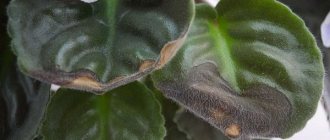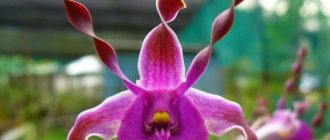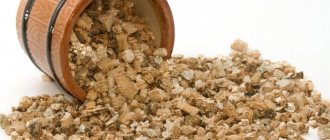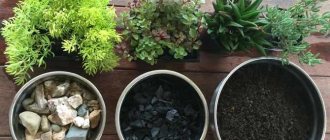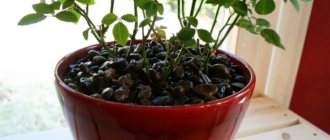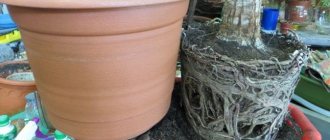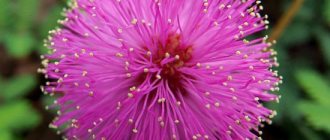Drainage is a layer of fractional material, the main function of which is to remove excess moisture. When watering abundantly in a flower pot, air exchange deteriorates. Because of this, a large number of pathogenic microorganisms and bacteria develop in the substrate. All this leads to orchid diseases.
Diseases are the cause of plant wilting, cessation of growth and subsequent complete death. Of course, the orchid in this state cannot bloom and discards the flowers that have already bloomed.
Drainage of the plant is necessary so that the rhizomes can breathe. Therefore, to avoid such problems, it is recommended to lay a drainage layer at the bottom of the pot. In addition to the drainage layer, do not forget about drainage holes through which excess liquid will escape.
Drainage for orchids
Let's learn more about drainage for orchids. A drainage layer or drainage is a layer of inert, water-permeable material that is placed on the bottom of a pot or other container with a plant to quickly drain excess water during watering.
Orchids do not always need drainage.
Various materials can act as drainage, such as:
- Pebbles;
- Or shards;
- Expanded clay is most often used.
Does an orchid need drainage? Based on the above definition, drainage is used when the pot is filled with a fine-grained substrate. Orchids are usually planted in a substrate based on tree bark. Such mixtures, as a rule, consist of components of a large fraction, which allows the substrate to pass air and water quite freely.
However, each composition of the mixture can be different from each other, and if we plant Phalaenopsis exclusively in coarse pine bark, then the presence of drainage here is absolutely useless, since the substrate easily allows all the water to pass through, so such pots are often soaked in basins with water rather than watered above.
It’s another matter if the orchid is terrestrial - it requires a heavier, nutritious substrate, therefore, the presence of a drainage layer is quite justified, since it will facilitate the outflow of excess water from the pot after watering.
Therefore, the answer to the question: “Do orchids need drainage?” is ambiguous and relative, it depends on what kind of substrate and pot are used :
- Relatively heavy, in a pot with solid walls or a flask (drainage is needed);
- Or light, in a perforated pot with holes (no drainage needed).
Advice! Before use, test the purchased or home-prepared mixture for water passage. Based on your observations, draw conclusions about the need for a drainage layer in the plant pot. Always use a pot with a hole in the bottom. There is no need to make holes in the pots.
In some cases, if transparent pots, glass vases or flasks are used, the drainage layer may consist of multi-colored pebbles and serve a purely decorative function without providing any practical benefit.
You can also observe in flower shops that orchids have no drainage . This fact is also proof that orchids thrive without drainage.
Root system
The plant receives moisture from the air through the growth of aerial roots. They also support the flower on loose soil and participate in photosynthesis.
But an orchid should not have many branched processes. This indicates poor care of the crop. The optimal number of aerial roots is 3-4.
If the soil is too dense, water stagnates in the soil, air circulation inside the roots stops, and they begin to grow. In this way, the root system “protects” itself from decay.
It will not be possible to completely remove the shoots, but you can reduce their number.
On a note!
There will be fewer roots if you water the orchid less often. This will prevent moisture retention in the soil.
Kinds
Expanded clay
A lightweight, porous building material obtained from clay shale . Expanded clay may have:
- Various shapes and fractions;
- Inert;
- Durable;
- And very accessible.
Many experts use expanded clay for orchids.
These positive qualities have made expanded clay the most popular material for drainage in floriculture. It has no significant negative properties.
Styrofoam
Roughly speaking, it is a foamed polymer . Foam has:
- A light weight;
- Non-toxic;
- Does not create favorable conditions for the development of algae and fungi.
From a large piece of polystyrene foam you can obtain fragments of the size required in a particular case. it degrades over time when exposed to sunlight . Looks untidy in a pot. In general, it is inferior to expanded clay in terms of durability and practicality.
River pebbles, pebbles
This material is practical on a par with expanded clay . Heavy weight will prevent accidental knocking over of a large, sprawling plant.
Instead of expanded clay, you can use pebbles or pebbles.
Also pebbles:
- Very decorative;
- And it has a very attractive appearance, which will help create an accent in a potted plant.
Advice! Make sure that the rock you collect from the river does not contain lime. This is very easy to check - drop vinegar on the surface of the fragment. Hissing and the appearance of foam indicates that the rock contains calcium carbonate, which is unacceptable.
Crushed stone, pieces of brick
Brick fragments are quite useful materials for drainage if you don’t have expanded clay or pebbles at hand. The positive side is that crushed stone and brick can be found in the city on the street or at any construction site/abandoned site, that is, you can get it yourself without financial expenses. A negative property is the low decorativeness of the material.
Crushed stone consists of limestone and contains calcium carbonates, which is unacceptable.
Shells
A poorly applicable material, since the shells primarily consist of limestone , which is unacceptable for the reasons stated above. Shells can also be randomly placed with the inside facing up and obstruct the flow of water.
Also, decorating pots with epiphytes with shells of underwater creatures, especially marine ones, is at least absurd from an aesthetic point of view .
What substances are inappropriate?
- Eggshell. Along with mollusk shells, it contains large amounts of calcium and other trace elements. Use as drainage is unacceptable;
- Dry leaves. As the layer of dry leaves deteriorates and decomposes, it will increasingly impede the outflow of water, which directly contradicts the purpose of drainage;
- Tree bark. It is already part of the orchid substrate. Pine, spruce or oak bark of a large fraction measuring 2-3 cm can be used as drainage, but it is better to put: Expanded clay;
- Pebbles;
- Or polystyrene.
- Mold;
Gribov;
It is better to find another use for the shell ;
Under no circumstances should marble chips be used instead of drainage.
Features of the procedure
Each procedure is fraught with pitfalls. For example, an adult and even an old specimen usually has a too massive root system, the volume of which will have to be slightly reduced. In general, transplantation can be combined with plant propagation. There are some peculiarities when moving a purchased orchid to a new pot. There are exceptions to the transplant rules for flowering plants.
Is it possible to replant flowering phalaenopsis?
There are differing opinions as to whether phalaenopsis can be replanted during the flowering period. However, all gardeners agree that the procedure is necessary if there are signs of infection or root rot. If you do not change the soil and cut off damaged roots, the orchid will die.
In this case, the peduncles are shortened after the fourth or fifth bud. Replanting is carried out with part of the old substrate (transfer method), but provided that no pests have infested it.
After purchasing in store
Orchids are usually presented in store windows in bloom. As you know, it is better to change purchased flowerpots immediately, which is not recommended during the flowering period. Transfer to another container is permitted in the following cases:
- the pot is damaged;
- the seller did not take good care of the flower, and rot formed on it;
- soil of poor quality was used, with a predominance of peat.
In the first case, it is better to refuse the procedure. The plant is left as is, placed in a pot until more favorable conditions arise.
Transplanting an adult plant
When transplanting adult plants, it is important to pay attention to the condition of the root system. To do this, after removing the flower from the container, place it in a container of water. Then the condition of the roots is assessed and, depending on their condition, a further decision is made:
- If the shoots are alive, then after being placed in water they turn green and become elastic.
- Gray and brownish-brown color indicates damage to the underground parts of the plant. Such shoots are removed to a healthy place. To do this, use a sharp instrument: scissors, pruning shears, after pre-treating it with disinfectants.
- In case of severe damage, complete root pruning is performed.
In the latter case, after pruning, the lower part of the plant is placed in warm water (about +30 °C). After a day, the roots are dried for an hour, and the water is changed and the orchid is lowered into it again. This is repeated for 2-3 months. When new roots appear, at least 5 cm long, the flower is planted in its usual substrate.
When propagating flowers
From one old plant you can get two copies at once by pruning. To do this, cut off the green top of the plant so that it has several strong roots. The leaves between them are removed. The sections are sprinkled with activated carbon or watered with 3% hydrogen peroxide.
The upper part is planted in prepared soil as described above. The lower part, with proper care, has a powerful root system. Some of the underground shoots are cut off, but not more than 30%. The roots are also planted in a container. The lower part is covered with damp moss.
Attention! When daily spraying a flowerpot in which only the lower part remains, the cut point (stump) must be covered so that moisture does not get on it.
Transplantation of children from the root is carried out when at least 3 roots with a length of 5 cm and 5 true leaves have formed on it. The process is separated as follows:
- remove the top layer of soil;
- cut off the root, which is attached to the mother plant, at a distance of about 1 cm from the baby;
- remove the resulting process;
- sections are treated with antiseptic drugs;
- plant the baby in the substrate.
Growing orchids in expanded clay
It is an experimental substrate for orchids. Most experts reject the use of expanded clay as a substrate, however, there is evidence and experience of successfully growing phalaenopsis on this building material.
Moreover, according to reviews from flower growers, plants planted in expanded clay feel much better than those growing in pine bark . In addition, expanded clay does not degrade like pine bark, which makes it a very durable “substrate”; plants practically do not require replanting. The downside is the need to feed the plants.
How to prepare drainage at home?
The material that you plan to use as drainage should be prepared and prepared in advance . It should be:
- Clean;
- Dry without traces of mold;
- And fungi.
It is advisable to disinfect it before use by calcining it in the oven. This applies not only to orchids, but in general to all plants that you replant. If necessary, place a small amount of drainage material at the bottom of the pot, necessary for the fraction of water to pass through easily, then you need to carefully place the plant in the pot, filling the free space with substrate.
Care after landing
In order for the plant to feel good, certain rules must be followed:
- do not place the flower pot in direct sunlight;
- maintain a temperature regime of 18-25 degrees;
- fertilize once every 20 days during the active growth phase;
- wash the soil once a week with running water to remove mineral salts.
Sunlight is important for orchids, but it should be diffused (for example, using gauze). There should be at least 12 hours of daylight, and therefore there is a reason to buy a special lamp for plants.
Moderate watering is as important for an orchid as the method of doing it (with running water for a few minutes, in a tray, or by lowering it into a basin). In summer it is worth watering a couple of times a week, in winter once every 2-3 weeks.
Orchid is a favorite plant of many gardeners. Despite its exoticism, this is an unpretentious flower, but it is worth knowing certain rules of care so that it takes root and blooms from year to year.
